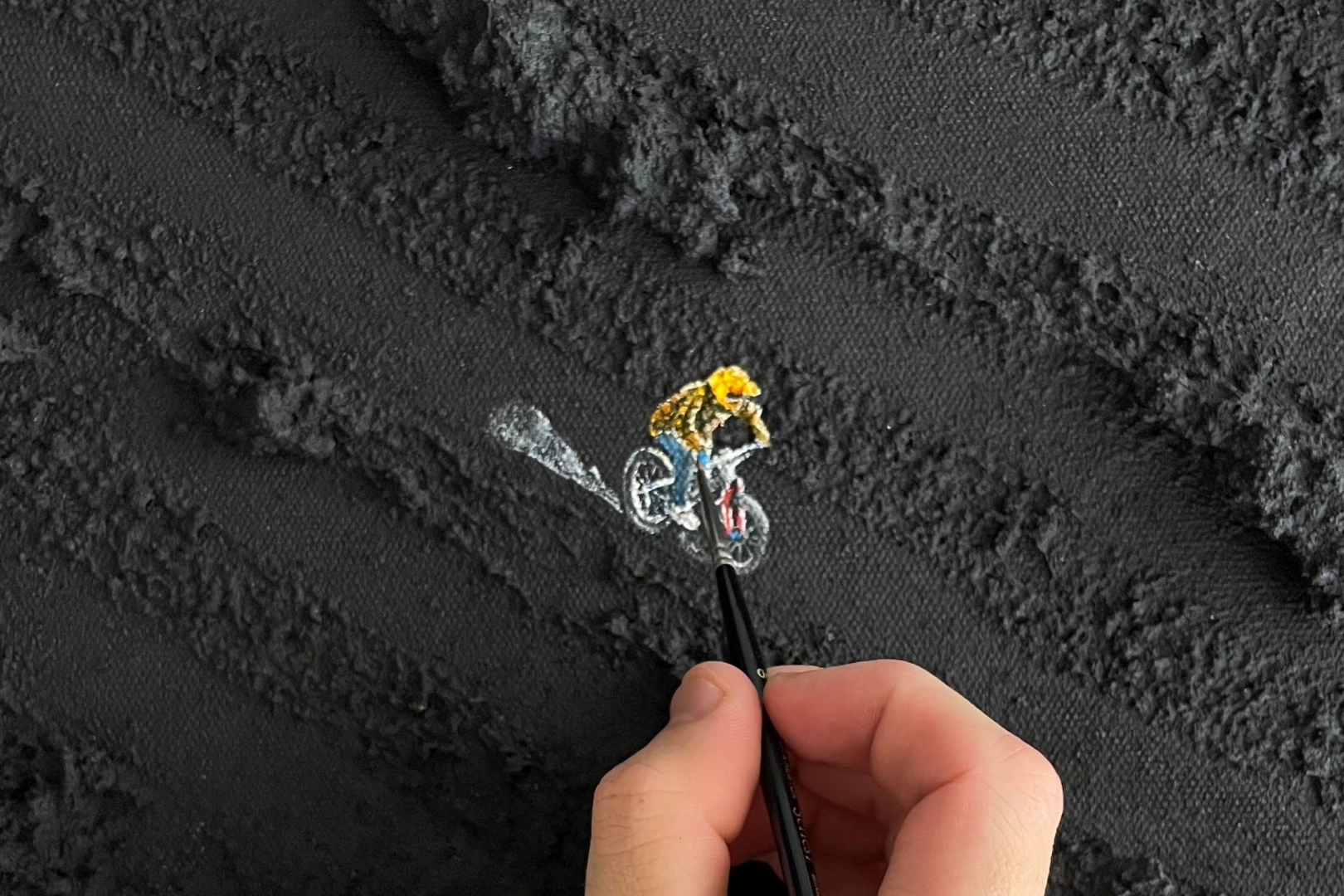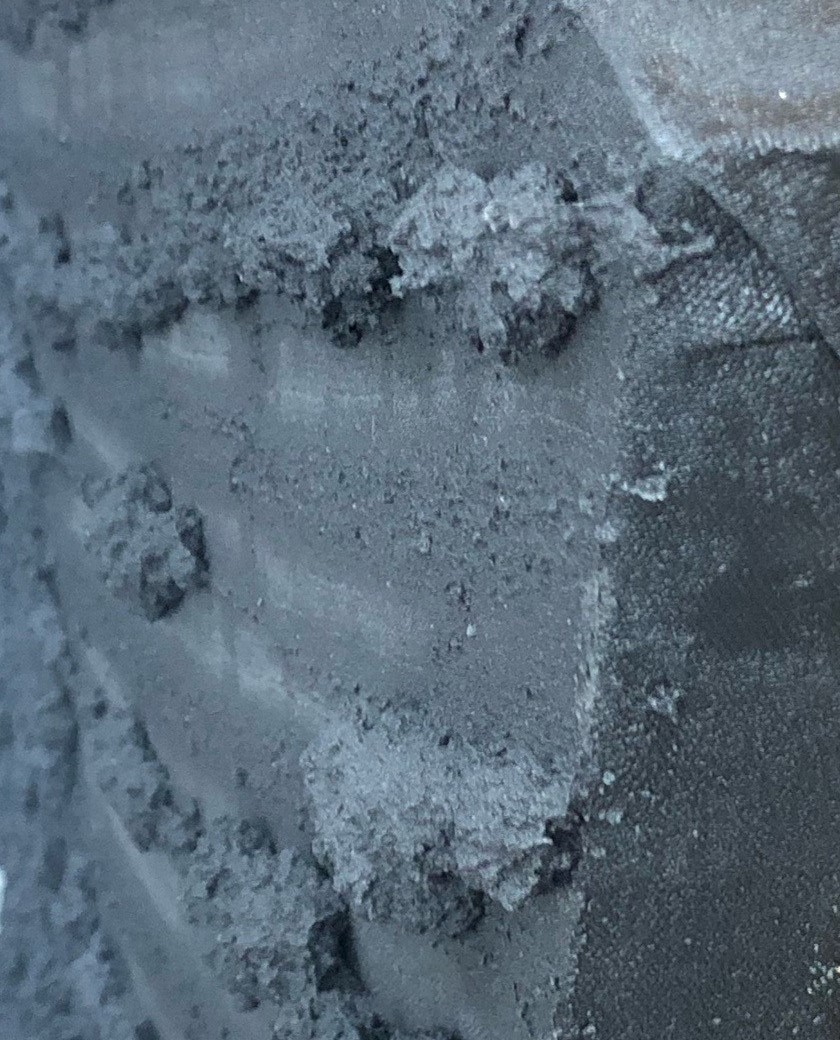Cycling down a volcano in Guatemala during an eruption while it’s spouting flaming rocks, collecting the volcanic ash and making it into a painting. This unprecedented fusion of sport and art occurred during the joint project Over the Edge by Czech biker Richard Gasperotti and South African, Australia-based artist Werner Bronkhorst, who describes this one-of-a-kind event in our interview. The painting, which is the result of their collaborative process, will be auctioned through the Mondraker bike brand. All proceeds from the auction will go to charity.
Athletic performances have been captured in a photo or video form many times before. But the Over the Edge project goes much further. Free-rider, multiple Red Bull Rampage participant, former speed record holder and adventurer Richard Gasperotti was the first person in the world to ride down three volcanoes in Guatemala. South African artist Werner Bronkhorst then used this unique moment as inspiration for his original painting. The whole project, from climbing the dangerous volcanoes to incorporating the volcanic ash into a unique artwork, was one big adventure.
THE INTERNATIONAL AUCTION of this artwork starts on Sept.8 from 12pm to Sept.10 at 12pm. READ MORE.
%20(kopie).jpg)
Richard fell in love with volcanoes years ago. When he was looking for somewhere to go after Etna and Stromboli, he found Guatemala, a land of volcanoes, many of which are still active. Fuego has enchanted him more than all others. He received support from the brand Horsefeathers and his team expanded to include photographer Miloš Štáfek, cameraman Ládis and manager Honza. They spent two weeks together in Guatemala, where they finally conquered not only Fuego but two other volcanoes.
„
It’s impossible to describe. You're high above the clouds,
while Fuego erupts in the background about four times an hour. And even when you ride back to base camp and lie down in your tent at an altitude of almost four thousand meters above sea level, the whole landscape below still feels as if you are holding it in the palm of your hand, and one of the most active volca
noes in the world is at your fingertips, glowing like a red fairground in the dark
At all three volcanoes - Pacaye, Acatenango and Fuego - Richard collected volcanic ash and pebbles and sent them to Werner Bronkhorst in Australia, who turned them into art. The artwork, which was created through a combination of extreme sporting feat and an unusual painting process, will now be auctioned in partnership with Mondraker, with the proceeds going to charity. "That's the best thing about our project together," agreed Richard and Werner.
The Guatemalan adventure also produced a video and this interview with the author of the final work:
Hot lava, mountain biking and art - putting it all together like that makes it sounds pretty crazy. Werner, can you tell us what the Over the Edge project is about?
The original idea came from a Czech biker, Richard Gasperotti, who went to Guatemala to bike down three active volcanoes: Pacaya, Acatenango and Fuego. The last one erupted during descent, spouting hot rocks the size of shopping bags. Fortunately, Richard survived the ride and collected ash from each volcano, which he later sent to me to Australia so I could incorporate it into a new painting.
How did you feel about creating a picture using ash collected from three volcanoes in Guatemala? What have been your first impressions about that?
„
Not every artist gets the opportunity to collaborate on truly amazing projects, let alone work with volcanic ash collected from active volcanoes. It’s insane to say the least but I’ve always made it my goal to push the boundaries with my art. What better way to do that than to mix paint with rocks?
How did your connection with biker Richard Gasperotti come about?
It was after I was approached by Sport in Atr’s Jan Dvořák over Instagram. He then introduced me to Richard. Richard’s energy, enthusiasm and daredevil-ness was too
good not to be part of, let alone an amazing opportunity to collaborate.
While your work includes many tiny surfers and skiers, the upcoming project involves mountain biking. Do you have your own biking story?
My uncle was an avid mountain biker so when he found out that I bought my first mountain bike with all of my birthday money when I turned 13, he made sure that I would fall in love with the sport too. He didn’t do much exercise as he had a full time job and two kids at the time but he would often take me to go cycling with him. A year later he entered the two of us into a 20 km competition. Not thinking much of my experience, he decided to go easy on me. Little did he know that I was cycling to school and back almost every day and we didn’t live in the flattest area. My year of training seemed to help because at the end of the competition, I had to wait an hour for him to arrive. That memory sticks out so much as I felt like a real man at that moment. Conquering rocky hills, muddy valleys, bushy trails… the feeling was unlike any other. I truly fell in love with cycling!
It seems you comb
ine miniatures - one could almost say comic book characters - against the rough background. How are your paintings created?
It’s funny you use the word ‘comic book characters’. Although comic books were a thing of the past when I grew up (as I was born in 2001), I loved vintage books, especially ones with pictures. Tintin, his adventures and his travels around the world inspired me to the point where I now explore new mediums in my artworks and ‘travel the world’ by painting scenes from any place on earth. I take the word ‘comic’ one step further in my artworks as one of the biggest parts in my artworks are the somewhat tongue-in-cheek, comical titles that make you laugh or think about topics the way comic books do.
How would you describe your work to somebody who wouldn't have the opportunity to see them in person?
Museums always have a ‘do not touch’ sign. I find this sad because not everyone gets to physically see art and therefore miss out on the beauty it has to offer. I love that I get to use texture in my
artworks as it draws people in to feel the smooth or rough textures of paint, wood and even plaster I use in the process. This is important to me as it gives blind people the opportunity to really appreciate my artworks as well. The way I would describe it to a blind person is to tell them how I see the world. To me, the whole world is a canvas, we’re just walking in it. I start my paintings by using materials like plaster, paint or wood to create abstract, textural backgrounds often in one solid colour. Then I paint little people swimming, skiing, cycling, walking, surfing… the list goes on. These paintings look like a bird’s eye view of the world we live in.
Do y
ou work quickly or create paintings in a deliberate, multi-step process?
My artworks consist of two main processes: abstract, textured and colourful backgrounds and realistic miniature paintings in the foreground. As I often make my own canvases and tools from scratch, the process takes a very long time, especially when it comes to the creation of the miniature figures that can each take between one to two hours to create. Some paintings have almost a hundred figures! But even before this, I think about collections and ideas for individual paintings a long time before I start creating. My previous collection “The Strokes” took an entire year to figure out. Either way, each artwork is very deliberately made although I can never fully predict what the outcome might be. It’s a constant process of trial and error with many steps in between.
How has the birth of your daughter influenced your work?
My daughter Florence is a constant inspiration as she sees the world through another perspective. It’s hum
bling to think back to what it was like being a kid - the world was so big and I felt lost in it all! Now, the world is in the palm of our hands. For that reason my paintings feature small people in a big canvas - like our world. The fact that I’m a young dad who gets to work from home also means that I get to spend a lot of time with her. She even paints with me while she’s in a baby carrier. I think it’s important that she sees how art is made and that she’ll be encouraged to create art as well.
Your Instagram follow
ing has skyrocketed in a short time. What was the turning point on the road to success?
I always joke that it was an overnight success that took 8 years. It was a gradual climb from one follower to another while jumping from project to project trying to find my style. I finally found it when I created my first artwork featuring skiers on a textured artwork which I posted to Tik Tok. It went viral which led to an entire collection of works. I’m just grateful that it was all such perfect timing!
What are your feelings about the connection between sport and art? How do these two activities come along?
Sport is such a democratic activity. Young, old, girl, boy, disabled, talented - anyone can do it to keep healthy or express their talents. Sport can also be enjoyed by anyone and has the power to unite people. Art is very much the same - it should be! Art can be made by anyone and for anyone and that makes
me feel so happy. Then of course you can only imagine what good things can come about when you mix the two together… MAGIC.
What are your goals for this year?
To keep pushing the boundaries set by other artists and viewers. I’m here to have fun and learn and to share great works of art while doing so. My goals stretch far beyond only this year but I can tell you that there are such exciting projects I have lined up - even an exhibition in London where my artworks come to life… You’ll have to follow the journey of mine on Instagram if you want to see what I mean.
Werner Bronkhorst is a self-taught contemporary artist based in Australia. He is recognized for his distinctive style, which involves combining abstract sculptural backgrounds with hyper-realistic paintings of miniature people. Werner has developed a unique gestural technique to create these pieces, and the result is a series of visually stunning works that explore the relationship between the small and the large, the real and the abstract.
https://wernerbronkhorst.com/
www.instagram.com/werner_bronkhorst/

%20(1).jpg)
.jpg)
%20(kopie).jpg)

.jpg)




